November 24, 2010
Set Up for Success.
By Bob Humphrey
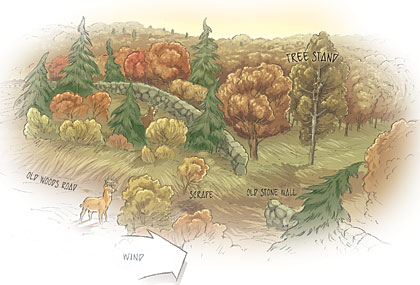 When it comes to stand locations, Brian Post of Full Fan Lodge in Pennsylvania says you can't beat a funnel during the rut. He loves to intercept cruising bucks by placing clients at openings along the area's many old stone walls. |
What is the ultimate treestand setup for whitetails? Ask a half dozen bowhunters from around the country and you'll likely get an equal number of different answers. Yet, each can be equally valid. No other game animal is as adaptable and occupies as broad and diverse a habitat range as the whitetail. With that in mind, BOWHUNTING queried outfitters from seven regions across North America -- different not just in terms of geography, but also habitat and terrain -- and asked what constitutes their ultimate bow stand.
What follows is a region-by-region summary of the outfitters' responses. Although you may be tempted to dismiss the tactics used in areas far from your home, there is much wisdom to be found in each scenario. With some careful study, you just might be able to borrow successful tactics from faraway places and make them work in your own backyard.
Advertisement
Northeast
Full Fan Lodge
Brian Post runs his Full Fan Lodge (www.fullfanlodge.com) in the rolling hills and mixed forests of northeastern Pennsylvania. The area was once known more for deer numbers than size, but state-mandated antler restrictions have made it a more desirable location over the past decade. Now, deer hunters from northern New England are coming down there, rather than the other way around.
His ultimate location is temporal, shifting within the Keystone State's long bow season. "Early on, we're hunting food: acorns, food plots and apples -- there are a lot of old farms around. During the middle of bow season, around Halloween, we get about five days of good scrape hunting," he says. "You gotta be there at that time, because it starts and ends quickly.
Advertisement
"When the rut hits, it's [time to hunt] funnels. Mid to late November, the chase is on. Some [bucks] are chasing, some locked down, but they're on their feet all day."
With larger blocks of forest, it may seem more difficult to locate funnels, but Post has discovered there are a lot of old stone walls in the woods, and they make great ambush locations.
As for stand type, Post uses a little of everything, depending on circumstances. "We have about 75 lock-ons and 20-30 ladders," he said, adding that "everyone's getting older, and ground blinds are becoming more popular." Climbers are welcome, and he often lets clients use their own.
For height, Post considers 16-18 feet optimal -- high enough to avoid a deer's notice but not so high you have an extremely steep shot angle. "When possible, I like to set up in pine or any kind of softwood for cover," he said. Otherwise, he opts for at least getting near a pine, or in a beech with lots of leaves.
"Obviously, wind is critical," Post said, "but this is farm country. Deer smell people all the time. If I had to pick one ultimate location, it would be in a pine tree, overlooking a scrape as big as a truck, on Halloween day and with the wind blowing the right way."
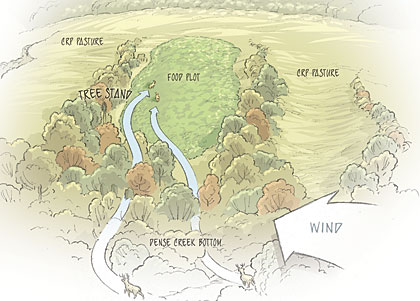 Darrell Hafford of Rocky Branch Outfitters in Illinois likes to place his clients on food sources close to bedding and sanctuary areas. |
Midwest
Rocky Branch Outfitters
"I started outfitting about 15 years ago," says Darrell Hafford. "I thought I knew everything, but I keep learning."
Hafford operates Rocky Branch Outfitters (www.rockybranchoutfitters.com) in one of the most underrated areas of the Midwest -- Southeastern Illinois. It's mostly farmland, with a healthy mix of small timber blocks and varying topography.
One thing Hafford has learned is the need to be versatile. Originally, he wasn't a big fan of ladders, but now they account for the majority of his stands. "All the clients can get in 'em," he said. "Even guys who are uncomfortable with heights."
During the rut, Hafford's ultimate setup is a 20-foot ladder stand over a food source. "I want to be close to a bedding area or sanctuary and right on the food source," he said. "That's where the does are gonna go, and the bucks won't be far away." He also likes that setup for the early season, because "bucks are still in bachelor groups and still hitting food sources hard."
Outside those periods, Hafford prefers a lock-on with climbing sticks for his clients. And he stresses concealment. "I try to find a bigger tree with lots of limbs," said Hafford, who likes to set his stands 20 feet high or higher. "The higher you can get your scent, the better, especially when hunting a mature animal."
Still, Hafford admits his personal preference is a climber. "I like to move," he said. "Hunting the same areas through the entire season, I can sit and watch deer for weeks, gradually moving into the right position when the time is right. And we have lots of trees set up with climbers for just that reason."
In this case, the ultimate stand is determined by a particular deer on a particular day, and it may take several days of observation to figure it out.
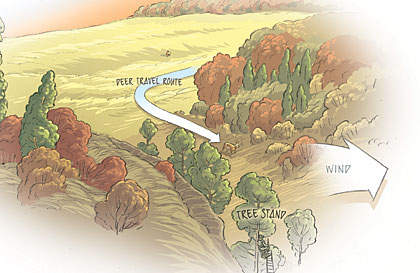 Scott Kirkpatrick of Buffalo County Outfitters in Wisconsin likes to place his treestands at pinch points created by steep ledges in his area. These natural funnels are ideal places to encounter rutting bucks in search of does. |
Upper Midwest
Buffalo County Outfitters
When folks think of whitetail hunting in the Upper Midwest, the first area that usually comes to mind is legendary Buffalo County, Wis., which is where Scott Kirkpatrick runs his Buffalo County Outfitters (www.buffalocountyoutfitters.com). The habitat and terrain aren't much different from Illinois, but the hunting pressure can be. "Buffalo County is often considered one of the most difficult areas to kill a mature buck because of the hunting pressure," Kirk
patrick said. "However, we have such a high density of mature animals, you can be just as successful hunting educated deer if you do everything right."
It doesn't hurt to have a very favorable buck-to-doe ratio, high deer densities and lightly hunted private land. "Our rut offers more big-buck movement than in many other parts of the country," Kirkpatrick said. And that's when he prefers to hunt.
Like many hunters, Kirkpatrick looks for funnels. In his case, however, he's looking for a particular type. "I want a pinch point deer use not because they like to, but because they have to," he said. "I'm not looking for a pinch point as defined by the corner of a field or trail to a bedding area. I want some type of constriction like topography. For instance, there are a lot of steep ledges in our part of the country. That forces deer into a narrow corridor."
The stand for his ultimate setup is a lock-on with climbing sticks. "When you're hunting pressured deer, you need something that has less presence," he said, "The less profile and the less mass you have in a tree, the better."
Kirkpatrick also believes that higher is better. "I rarely hang a stand lower than 20 feet. I've tried lower stands, and we do hang them to accommodate clients, but above 20 feet is where our hunters have had consistently good encounters without being busted."
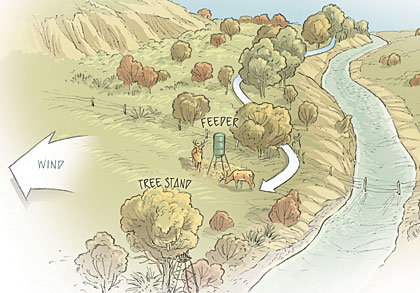 Feeders and deer hunting go hand-in-hand in Texas. Outfitter Bill Whitfield says his best stands are tripods tucked into cover adjacent to feeder locations. |
Texas
Bill Whitfield HuntsTexas is different, in so many ways. Bill Whitfield (www.billwhitfieldhunts.com) guides in Palo Pinto County, very hilly country covered with mature hardwoods, mostly oak and some cedar. But that really doesn't matter. "We hunt where the deer are," Whitfield said, "and in Texas, that's where the feeders are."
Whitfield also sets stands at fence crossings or along trails going to feeders. They use primarily 12-foot tripods. "On our ranches, 12 feet is high enough because of extremely low hunting pressure," he said. Still, the typical setup is to assemble the tripod so it is literally within the branches of a tree for maximum concealment.
Choosing the best time of day isn't rocket science either. "Bowhunting in Texas is basically daylight until about 9 a.m. Then it's over," said Whitfield. "And in the afternoon, from about two or two-and-a-half hours before dark until dark. They hunt all day in the Midwest because they have to. We don't. We let our deer rest."
What's also different is that it's not the habitat or the season that matters most. In Texas, the ultimate stand is defined more by when than by where. "The best hunting is during the dark of the moon," said Whitfield. "When we plan out our fall hunt calendar, we hide from the full moon, especially during bow season."
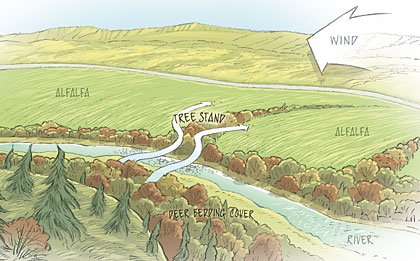 Doug Gardner of Gardner Ranch Outfitters in Montana pays careful attention to local deer patterns and places stands downwind of preferred travel routes between bedding and feeding areas. |
West
Gardner Ranch Outfitters
Doug Gardner's Gardner Ranch Outfitters (www.groutfitters.com) operates along Eastern Montana's Powder River. In addition to pronghorns and mule deer, the area hosts some of the best whitetail hunting in North America. Immediately adjacent to the narrow, brush-choked river lies acre upon acre of irrigated alfalfa. Each afternoon, deer pour out of the limited cover and disperse across the lush agricultural fields.
At first blush, it seems obvious that you should set up on the field edges, intercepting deer as they come out to feed in the afternoons. And that's exactly how Gardner hunts, though it's not quite that simple. "Because the river margin is so narrow, we have to set up fairly close to where they bed," he said. "I prefer to set up back in the timber when I can, because the deer feel more comfortable there. That's not always possible though, and we often end up setting up on the edge."
Because conditions are so similar along the river bottom, the ultimate stand location often depends less on habitat and more on the deer and the wind. "We do a lot of scouting, and we know the bucks we want to harvest," he said, explaining that they watch for a pattern. "Then we put stands in the best spots and wait until the wind is right."
Even then, there are no guarantees. "The wind may be perfect for an approaching buck," says Gardner, "but what happens when the does go past you and end up downwind? You still need a little luck."
Like Hafford, Gardner has learned from his years of guiding. "When we first started, I didn't believe ladder stands would work. Over the years, I've been proven wrong. If they're placed properly, the deer don't seem to have any problem with them."
That makes Gardner's job a lot easier in a place where about the only trees big enough to support a stand are giant, twisted cottonwoods. "Ladders are a lot easier to set up in crooked tree," he said, adding that his clients also find ladder stands more secure and a lot easier to get in and out of.
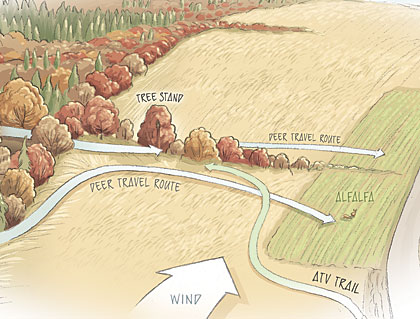 Neil Johnson of North Star Outfitting in Alberta picks hedgerows adjacent to bedding areas as his favorite stand location. These locations are ideal for intercepting deer as they move from bedding areas to feeding areas. |
Northern Canada
North Star Outfitting
Northern Canada is legendary for giant whitetails, and Neil Johnson of North Star Outfitting (www.northstaroutfitting.com) guides in the heart of Alberta's big-buck country. He hunts primarily along the fringe, between open agricultural land and large blocks of timber, consisting mostly of aspen, birch and conifers.
Rather than hunt the edges, however, Johnson's ultimate bow stand is a hedgerow. "I try to find one that's narrow enough where the deer won't bed in it, but the cover is thick enough so you don't get skylined," he said. "What I'm looking for is a travel corridor between a bedding area and where they're going to feed in an alfalfa or pea field, a place where they'll travel before dark and
still feel comfortable."
He faces a similar situation to Gardner's in that he's often setting up very close to bedding areas, only in his case it's by choice rather than necessity. "I try to get as close to the bedding end [of the hedgerow] as possible," Johnson said. And with more cover, Johnson is less concerned about spooking deer. In fact, he'll often move deer back just so he can get his hunters on stand. He even prefers driving his hunters to their stands on an ATV.
"I may bump a few deer at first, but they only move a short distance, and if I drive in regularly they get used to it," he said. "Then, when I take a hunter in, it leaves far less human scent." Johnson also prefers the hedgerows to the forest edge because deer will travel it earlier in the afternoon, often waiting until dusk to enter a field.
"A key element," he said, "is finding a field that never has cattle in it so the deer graze in it and feel comfortable year round." He also notes it's better if the area is back off the main roads, isolated in a draw or off a river -- the kind of place people don't often go.
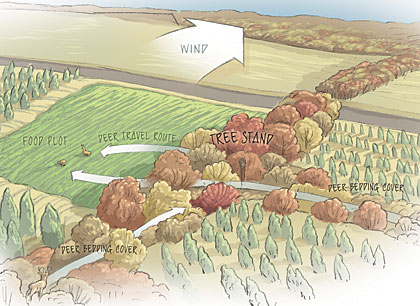 Fred Law of Enon Plantation in Alabama likes to place his stands at pinch points in hardwood drainages. Ideally, there will also be bedding cover and food sources -- which change over the course of the season -- nearby. |
Southeast
Enon Plantation
Most of Alabama is relatively flat, and much of the landscape is a mosaic of pine plantations or crops in the uplands and hardwood forest in the bottoms. And few managed properties are without their share of food plots.
At Enon Plantation (www.enon.com), Fred Law likes pinch points or bottlenecks, which usually occur in the hardwood drainages, for his ultimate bow setup. "I look for anything to narrow 'em down, be it cover, field edges or natural terrain," Law said. And he emphasizes finding the narrowest point. "Try to find a spot where if you see deer, they're gonna be close enough for a bow shot."
When and where possible, Law also likes to be close to a bedding area, especially when hunting big deer. "And of course, there's got to be food nearby," Law said.
For his stands, Law prefers a lock-on and tries to set it no lower than 20 feet, with plenty of cover around it. "Sometimes," he said, "limb cover dictates how high you can go."
His ultimate stand location shifts through the season, mainly as food sources change. They typically hunt mast crops early. "Later in the year, when natural food like acorns are gone, we hunt food patches [plots]," he said. "During the rut, we set right up on the food patch. Outside the rut, if you want to see a lot of deer and maybe shoot a 2 ½-year-old buck, you can hunt the patch. If you want to get something nicer, you gotta stay off the patch, where they stage up. You won't see as many deer, but€¦" he trailed off, leaving the unnecessary unspoken.
Conclusion
So, what can we conclude from all this? At first glance, it might seem a bit confusing. What good is advice from a Montana outfitter to someone who hunts the expansive forests of the Northeast? How much value is there to a Midwesterner in knowing how they hunt in Texas? The answer, in both cases, is a lot.
Bear in mind these guys are not hunting for themselves, but catering to multiple clients. In many ways, that means they must be extra careful about where and how they place their stands. Ladder stands seemed most popular, but several outfitters admitted that was sometimes a matter of safety and convenience and that lock-ons or climbers might be a better choice under certain circumstances, like hunting Buffalo County's pressured deer, or when you have the time to make incremental movements over several days. And while height preferences varied, all our outfitters pointed out the importance of concealment and getting your scent up off the ground.
The wind? Though not always mentioned in the text, all the guys made some mention of it, not as if it's not important, but more that it almost goes without saying. You have to mind the wind, always.
A lot of it boils down to common sense. Look for the generalities. Post's stone walls, Johnson's hedgerows and Law's pinch points are all funnels between bedding and feeding areas. Both Hafford and Gardner stressed scouting and observation. Sometimes, you can't tell the ultimate location until you've studied the individual deer in the area. And as Whitfield showed, even when all other things are equal, extraneous factors such as weather, temperature and even the moon play a role in not where, but when is the ultimate bow stand.
Food, bedding cover and funnels. You need to know first which is most important, and second what those look like in whatever part of the country you hunt. Then you can find your ultimate setup.
